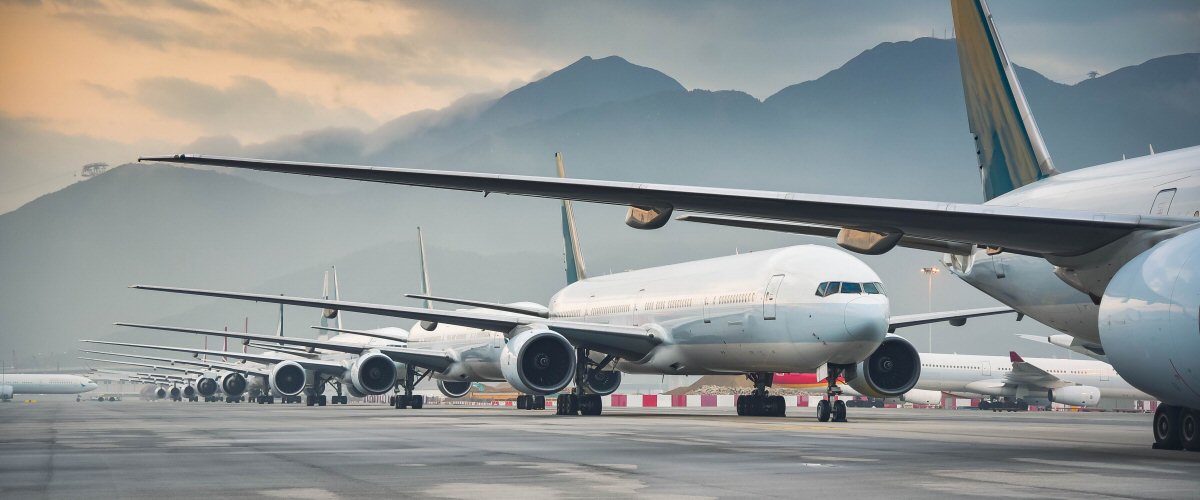Date: 31/05/2024 (Edition 10) Download PDF
.png)
In a scenario reminiscent of its past, SpiceJet’s active fleet continues its yoyo decline which begs the question of where they go from here. Over its 20-year history, the operator has made some bold decisions to grow in the Indian low-cost battleground yet continues to face critical cost barriers that force it to retrench its position.

Source: IBA Insight
As the IBA Insight chart above shows, the narrowbody fleet grew steadily up to the start of 2014 to reach 43 737NGs, whilst competition against Kingfisher and high fuel costs compounded the losses. As such, the fleet was halved. The subsequent failure of the competition and the oil price collapse triggered growth once more, although it took the further collapse of Jet Airways to provide the rapid lift (and market space) it required to reach its peak fleet size in December 2019. Since then, losses sustained during the global pandemic years have taken their toll leading to legal challenges from lessors looking to deploy in the current recovery cycle.
In a little over two years, the fleet has dropped by more than 55%, and 70% since the end of 2019 such that they have just a handful of MAX 8s (owned by ICBC, BOC and a wet-leased ALC aircraft from Corendon), 14 x 737-800s (mostly with Carlyle and some more wet-leased aircraft from Corendon), and a large Q400 fleet that is mostly now owned and in storage. A week doesn’t seem to go by without reading a headline that yet another lessor has settled on outstanding debts, or an aircraft has been repossessed. Of course, if the Indian courts had played ball, the fleet could have reduced much faster, increasing the likelihood of total failure. To top it all, fraud allegations triggered the departure of three senior commercial executives, including their Chief Commercial Officer.
But for what would normally signal a collapse for most other airlines, SpiceJet remains active in the market trying to secure capacity ahead of the summer schedule, fundraising, whilst fighting off IndiGo, a stronger Air India group, Vistara and Akasa.

Source: IBA Insight
Looking at the entire passenger market within India over 20 years, SpiceJet has certainly faced tough competition in this rapidly growing sector. Whilst 20 years ago, the total number of active passenger aircraft equalled just 150 units, today it's>650, with a further 180 stuck in storage. Adding in the 1,975 on the backlog for India (129 of which are with SpiceJet), the battle for third place will have to form an orderly line behind IndiGo’s and Air India’s capacity dominance. For SpiceJet, the future remains uncertain whilst they continue to battle with high costs and fewer chances for revenue given their fleet status.
In the past month, market movements have been muted but many March year-end results have come out, two of the highest profile of these being Wizz and Ryanair. Unlike the US LCC sector, the European counterparts reported shining news, with Ryanair hitting records again and Wizz back in the black for the first time since 2019. However, both company’s management commentary wasn’t so rosy, lamenting the scale of delivery delays for both Boeing and Airbus going forward.
As has been an enduring theme, Ryanair’s low leverage (Assets/Equity), which they decreased further to just 2.3, kept finance expenses low, allowing revenue to trickle down to net profit. For context, easyJet is at 3.6, whilst Wizz’s narrow equity position after sustained losses puts them at 59.7. Ryanair’s net profit of US$2.0bn (net margin 14.3%) was a 34.2% increase on last year, and almost treble 2019. This was helped by revenue increasing 24.8%, off only a 9% passenger increase, demonstrating a healthy yield rise! This is despite route data from IBA Airlines showing only minimal changes in the airline’s network year on year.
The total operating expenses increased by a similar amount to revenue (23.7%), led by a 32.0% increase in fuel. The airline’s reputation of cost control kept the other cost increases more in line with traffic increases. However, the airline’s strategy of heavy use of hedging has perhaps eroded some competitive advantage as they are locking in the higher prices at the fuel’s peak. Looking forward, CEO Michael O’Leary has highlighted that the fleet will only increase from the 2023YE number by 12 before the Q3 peak demand, 23 aircraft less than contracted with Boeing. To keep their aircraft flying, the airline is reportedly considering investing US$499m into a new maintenance facility in Lithuania.
Wizz Air’s net profit of US$385m (net margin 7.0%) isn’t in the same league as Ryanair’s but should be lauded for being significantly positive again, especially with the 24.5% up in capacity. The airline also improved profitability, moving on from its widely known fuel hedging lapse in FY22/23 (accounting for 45% of its CASK that year). Despite the capacity ramp-up, the fuel cost dropped by 5.1% this year. The airline is market-leading in cost, with the CASK down to 3.8 cents. Ryanair and easyJet’s last annual CASKs were 4.2 and 6.8 respectively. If they get back up to the 94% load factor of 2019 (currently 90%), they will compete on the RASK front.
Wizz highlights that their Israel lost revenue represents approximately US$87m. The airline also reported 45 aircraft grounded due to the GTF issues as of March 31st, fortunately, abated by 39 A321 deliveries. The airline expects 50 grounded through Q2 and Q3 this year. Unfortunately, Airbus delays, perhaps linked with sourcing the engines, put their FY24/25 deliveries down to only 21. It would take a long time to clear their 321 aircraft backlog at that rate!
The European carriers have reported another jump in profits, but with limited aircraft supply from both major OEMs, it is left to passenger yield for profitability, which ultimately has a limit for consumers. 2023 may have been the airline industry's peak for some time.
Following on from Neil’s discussion earlier this month around IndiGo investing in long-haul, India’s largest airline is set to make another significant shift by introducing a business class product “tailored for the country’s busiest business routes”. This is a deviation from the single-class cabin it has operated since its inception in 2006. While the airline has noted its first net profit since March 2019 of $986m (11.9% net margin), in 2024, it is hoping to increase profitability by capitalising on the premium segments. These are reportedly growing at 100-200% year on year in India.
The details surrounding IndiGo's new business class remain sparse, with more comprehensive information expected to be unveiled around August. The airline could opt for special business class seats like those of Air India and Vistara, akin to short-haul business class carriers such as Turkish Airlines and Qatar Airways. Alternatively, IndiGo might introduce a more budget-friendly business class, featuring the first few rows with blocked middle seats, similar to the business class setup within Europe. This solution provides the carrier with far greater flexibility, making maintaining high load factors easier. Given IndiGo’s budget-conscious approach, the latter scenario seems more likely, though the airline's emphasis on redefining business travel suggests a potentially more sophisticated offering.
This strategic shift comes as IndiGo prepares to expand its long-haul operations, with orders for Airbus A321XLRs and Airbus A350-900s. If successful in the short-haul operations, the new business product will surely make its way into the long-haul segment. It’s important to note that building a profitable long-haul product is arguably more difficult than creating a business one for short-haul.
However, this move does raise questions about whether deviating from its low-cost model might affect IndiGo's profitability. The transition to offering premium cabins is a gamble that could either enhance the airline's market position or challenge its established economic model.
Our regular update looks at the key trends and market indicators using data and analytics provided by IBA Insight.




Introducing IBA Insight, IBA NetZero and IBA Airlines – aviation's one-stop shop for intelligence. You need quick, intuitive access to the most accurate commercial aviation data. Our products are designed to provide you with seamless and simple analysis, prompting better asset decisions, enhanced risk management, and a full understanding of aviation decarbonisation strategies.

With our large team of award-winning ISTAT-qualified appraisers and over 35+ years' proprietary data, IBA is a leading player in the valuations market. Working globally, we offer independent, impartial opinion and advice on the value of a range of asset types including aircraft, engines, helicopters, freighters and air cargo, landing slots and spares. Always striving to exceed clients' expectations, IBA's objective judgement supports the required security needed for loans, asset repossession, commercial development and remarketing.

IBA works with leading aircraft and engine leasing companies from around the world. Our depth of industry knowledge informs our expert advice so we can support clients through the investment cycle, inspiring confidence at every stage of their journey. From valuations, fleet selection and portfolio development to redelivery and remarketing at lease end, we accompany clients through every risk assessment and asset management activity during the life of the lease.

Aviation investment can be an intricate affair and, with significant financial stakes involved, leaving things to chance is not an option. Whether you are investing for the first time or an established player in the market, IBA can help you cut through the complexities of the asset class to better understand investment opportunities. We can work with you to support portfolio development, diversification and to meet strategic needs.

For over 30 years IBA has worked with global and regional airlines providing valuation and advisory services, aviation data intelligence and aircraft and engine redelivery support. Working collaboratively on a variety of aviation projects spanning the world, we fulfil clients' additional resource requirements and provide project management support wherever and whenever needed.

We take a resourceful approach to litigation support and dispute resolution, identifying thoughtful solutions that are tailored to our clients' legal strategy. Our access to over 30 years of proprietary aviation data, regular involvement in strategic M&A and aircraft management expertise affords us regular access to the typical areas of contention between parties. IBA assists clients directly or via their legal teams across many aspects ranging from insurance related settlement for aircraft damage or loss, to disputes between lessors and lessees - often at redelivery.